Vol 2 No. 11 TROPIC LIGHTNING NEWS March 20, 1967
Index
LRRP, CIDG Hammer at Nui Ba Den
By PFC Mike Heacock
The 196th Lt. Inf. Bde.'s Long Range Reconnaissance Patrol (LRRP)
began an ambitious operation on Nui Ba Den Mountain, the "Black Virgin" that
dominates the terrain of Tay Ninh Province like a rock pile set on a pool table.
The mountain has been the home of Viet Cong units since the first
days of the war. Its many natural and man-made tunnels under the granite
blocks that stud the mountainside make it a natural fortification that is almost
impregnable to artillery fire and air strikes.
Some of the tunnels are thought to be more like huge caverns,
possibly housing whole battalions or regiments of Viet Cong as they pass through
the province, with hospitals and arms repair factories hidden deep in the bowels
of the mountain.
One tunnel suspected of being a major hideout and storage area for
the Cong was recently probed by the LRRP and a Vietnamese Civilian Irregular
Defense Group (CIDG) reconnaissance platoon, operating as tunnel rats in
four-man teams, with two men from each group working together underground.
After clawing their way up the steep side of the Black Virgin, the
LRRP, the CIDG platoon, and two security platoons from the 196th Bde.'s Co. A,
4th Bn., 31st Inf., moved through the bazaar at the Buddhist pagodas, about
half-way up the mountain, and then on about 35 meters beyond.
A United States Special Forces "A" team had previously spotted
what they believed to be a large complex at this spot, and it wasn't long before
the first of the search teams had entered a minute opening under a huge boulder,
into a small underground room with many exits.
Going deeper into the mountainside, the search teams were intrigued
by arrows painted on the tunnel walls, apparently used by the Viet Cong as road
signs. Many large sleeping rooms were discovered, all showing signs of
use. But on the third day, the 300-meter tunnel came to a dead end, about
10-meters above the spot where the men had originally entered.
Undaunted, the LRRP and CIDG platoons immediately searched another
tunnel, which had been discovered a little further up the mountain.
Accompanied by tunnel rats from Co. A's security platoons, the search teams
moved cautiously into the second hole and discovered documents, clothing,
cooking utensils and small amounts of recently cooked rice and beans.
However, this tunnel also proved to be a dead end and the men descended the
mountain to join other units in Operation "Junction City."
There are literally hundreds of tunnels used by the Viet Cong on
Nui Ba Den, and probably not all will ever be destroyed. But if they can
be discovered, charted, searched and mapped, intermittent harassing fire by the
artillery, at the entrances to the holes, can make them too dangerous for the VC
to use. And repeated "raids" on selected complexes, by units such as
the LRRP and CIDG, will finish whatever usefulness they might have retained.
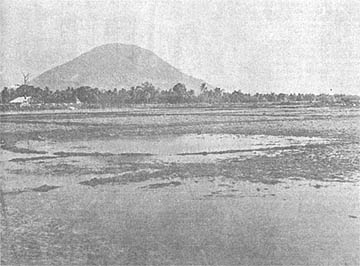 |
|
. . . like a rock pile set on a pool table |
Viet Saved in 'Impossible' Rescue
The jungle canopy rose to a towering height; below, in a small
clearing, not large enough to hold the Huey helicopter orbiting overhead, RVN
marines waited for the cargo aboard to be delivered.
The aircraft commander, WO Fred E. Startz of Greensboro, N.C., of
the 196th Lt. Inf. Bde. knew the cargo had to be delivered because the marines
were in need of the radio batteries he had aboard. The only solution was
to drop the batteries from the Huey into the small clearing. The "air
drop" was on target.
Mission completed, Mr. Startz and his pilot, 1st Lt. Robert E.
Crawford of Starkville, Miss., also with the brigade's aviation section, were
told by the ground troops a "Dust Off" was needed for a wounded marine.
Though the medical evacuation (MEDEVAC) helicopter had been requested, the two
pilots sensed the difficulties that could be involved in the evacuation and
orbited their ship on station.
Mr. Startz recalls, "When we were told that they (RVN marines)
needed a dust off, we knew the MEDEVAC chopper would have trouble getting in.
The jungle canopy was at least 60 meters high where the evacuation was needed.
To accomplish the MEDEVAC, the chopper would need a sling hoist long enough to
get the casualty out.
"We continued to orbit in the area for almost an hour, waiting on
the dustoff. He must have had trouble getting the sling hoist."
Mr. Startz and Lt. Crawford knew the importance of getting the
wounded marine to medical treatment as soon as possible. They had flown
this type of mission many times before. Something had to be done.
The jungle hid their position like a giant canopy hanging overhead,
so the pilots instructed the marines by radio to ignite a smoke grenade at the
position of the wounded man so his exact location could be determined.
Minutes later the smoke became visible to the pilots through the undergrowth and
giant trees. A small clearing, created by a bomb from an earlier air
strike, was spotted by the pilots some 300 meters from where the wounded man
lay.
The marines were given the azimuth to the bomb crater and advised
to move the wounded marine to that location. Traveling with the wounded
man in such conditions was no easy job, but the RVN marines made it.
The job of the two American pilots had just begun. The
clearing was too small to let in the chopper, and even if they got in, there was
no place to set down. Slowly the pilots inched the chopper into the tiny
clearing, as the door gunners kept watch to insure that the tail rotor blades
would not strike the massive trees.
The downward blast of air from the main rotor helped clear the way
for the descent, pushing the branches and limbs out of the way, and the chopper
was lowered to within feet of the jungle floor, hovering over the bomb crater.
The wounded marine was placed aboard the craft.
Lifting up and out of the jungle "well" challenged the skills
of both pilots. "Going in, we had the rotor wash to push some of the
trees and under-growth aside, but coming out we had no rotor wash," said Mr.
Startz as he told of the experience.
Like skilled engineers, they hacked away, widening the walls that
surrounded the jungle hole as they slowly ascended. The tool used to do
the job - the main rotor blades.
Once again above the jungle that had temporarily entrapped them, a
50 km trip was made to the 45th Surg. Hosp. at the brigade's base camp.
The dust-off completed, the pilots inspected their aircraft.
Lt. Crawford, also the aviation section's maintenance officer, mused, "the
blades of the rotor (which cost $40,000 per set) were completely ruined.
The leading edges were peeled away. When this happens, the chopper can't
be flown. When I realized how far we'd flown, I was amazed that we made
it. I guess you could say this was a '$40,000 dust off', but the
important thing was getting the wounded RVN marine to the hospital."
Miraculously, they did.
17 Cong Die In 'Junction'
II Field Force, Vietnam, reported 17 enemy killed during light and
sporadic contact in the joint air-ground Operation "Junction City" recently.
Friendly casualties were four US killed and 20 wounded.
The multi-division operation was supported by 113 strike sorties.
Two B-52 raids supported the operation this morning hitting enemy base camps
some 40 km northwest of Tay Ninh City.
AF Airdrops Supply 196th Units in Field
The means of resupplying a combat unit in the field may take many
different forms. It may be done by the conventional 2 ½-ton truck, or by
sleek Huey or giant Chinook helicopters.
For the 196th Lt. Inf. Bde. in Operation "Junction City," it
took the form of U.S. Air Force C-130 Hercules aircraft, which airdropped tons
of supplies into the brigade's three forward areas near the Cambodian border.
The method was advantageous because it did not require secure roads and could
deliver a larger payload. It was the first time this method was used to
resupply non-airborne units.
Using the Container Delivery System (CDS) for the first time in
support of combat troops in the field in Vietnam, the C-130 aircraft, assigned
to the 834th Air Div. at Tan Son Nhut Air Base, flew 27 sorties and dropped
approximately 300 tons of supplies to the brigade elements. In the CDS,
the supplies are loaded on 44"-by-44" platform pallets, which are attached
to the parachute. There are 16 to 24 pallets per plane load.
A three-man Air Force combat control team aided the airdrops,
controlling air traffic and providing a ground-to-air control for the resupply
planes. A five-man re-rigging team jumped after the supplies to inspect
the equipment and repack the chutes.
Page 2 TROPIC LIGHTNING NEWS March 20, 1967
Decorated
| SILVER STAR | |
|
1st Lt. Bruce G. McDougal, Co. C, 2nd Bn., 27th Inf. Sp4 Francis L. Lentz, Co. C, 2nd Bn., 1st Inf. |
Sp4 William J. Schneider, Co. C, 2nd Bn., 1st Inf. PFC Dale E. Pollard, Co. A, 2nd Bn., 14th Inf. |
|
BRONZE STAR MEDAL |
|
|
Maj. Robert L. Roby, HHB, 25th Div. Arty. Maj. Donald L. Winters, HHD, 25th Avn. Bn. Capt. George W. Arnau, Hq & Co. A, 25th Med. Bn. Capt. Walter R. Hayes, Hq. & Co. A, 25th Med. Bn. Capt. Charles Johnson, HHC, 4th Bn., 9th Inf. Capt. Vaughn Timberlake, HHB, 25th Div. Arty. Capt. Marvin Walker, Hq & Co. A, 25th Med. Bn. 1st Lt. Michael Rothstein, HHC, 65th Engr. Bn. 1st Lt. Robert L. Russell, Btry. B, 7th Bn., 11th Arty. SMaj. John B. McMahan, Hq & Co. A, 25th Med. Bn. |
1st Sgt. L. C. Bishop, HHC, 4th Bn. (Mech), 23rd Inf. 1st Sgt. Charles Padgett, Btry. C, 7th Bn., 11th Arty. 1st Sgt. Calvin E. Stanley, HHM, 25th Div. Arty. SFC Lucius A. Dewberry, HHC, 25th Inf. Div. PSgt. Willie Hicks, Co. C, 25th Med. Bn. SFC Wayne Hoffman, Co. E, 725th Maint. Bn. SFC David Martin, HHC, 25th S&T Bn. SFC James Raymond, Co. E, 725th Maint. Bn. SFC Robert Turner, Hq & Co. A, 25th Med. Bn. |
| ARMY COMMENDATION MEDAL |
|
|
Sp4 John J. Schmidt, HHC, 2nd Bn., 27th Inf. Sp4 Ronald G. Smith, HHC, 2nd Bn., 14th Inf. Sp4 Donald H. Snead, Co. B, 125th Sig. Bn. Sp4 William Sturdivant, HHC, 2nd Bn., 14th Inf. Sp4 John T. Thornton, 25th MP Co. Sp4 Richard L. Wilkins, HHC, 2nd Bn., 27th Inf. PFC Marion Cole, HHC, 2nd Bn, 14th Inf. PFC John J. Haslam, HHC, 2nd Bn., 14th Inf. |
PFC Larry J. Kralik, HHC, 2nd Bn., 14th Inf. PFC Kenneth L. Lunsford, HHC, 2nd Bn., 14th Inf. PFC David Prezenkowski, HHC, 2nd Bn., 14th Inf. PFC Willis E. Price, HHC, 2nd Bn., 14th Inf. PFC Dennis Reiss, HHC, 2nd Bn., 14th Inf. PFC Alvin Shelborne, HHC, 4th Bn., 9th Inf. PFC Matthew Vuolo, HHC, 2nd Bn., 14th Inf. |
| PURPLE HEART |
|
|
Sp5 James T. Murry, Trp. F, 17th Cav. Cpl. Dennis McKale, Co. D, 2nd Bn., 1st Inf. Cpl. Earl West, Trp. F, 17th Cav. Sp4 William Ash, Co. C, 2nd Bn., 1st Inf. Sp4 Samuel Benavides, Trp. F, 17th Cav. Sp4 Charles W. Bolton Jr, Co. A, 4th., 31st Inf. Sp4 William Commins, Co. B, 2nd Bn., 1st Inf. Sp4 Thomas J. Cox, HHC, 3rd Bn., 21st Inf. Sp4 Tommy J. Franks, Trp. F, 17th Cav. |
Sp4 Darrel M. Green, Co. B, 3rd Bn., 21st Inf. Sp4 John W. Herron, Co. B, 2nd Bn., 1st Inf. Sp4 Donald E. Jones, Co. B, 3rd Bn., 21st Inf. Sp4 Thomas G. Kirk, Co. A, 2nd Bn., 1st Inf. Sp4 Jerrald K. Lake, Co. C, 2nd Bn., 1st Inf. Sp4 Frank Spencer, Co. A, 4th Bn., 31st Inf. Sp4 Paul R. Storer, Co. B, 2nd Bn., 1st Inf. Sp4 Franklin T. Williams, Co. B, 2nd Bn., 1st Inf. PFC Sammy Allen, Co. C, 2nd Bn., 1st Inf. |
Ex-Cong Begin New Life in Xuan Loc Province Center
The village resembles any one of hundreds of Vietnamese
communities.
The men and women of Xuan Loc work in the fields and shops.
Children help their parents or chase animals around the streets. One youth
asks a soldier to join him and his companions in a game of volleyball.
Others mill near a visiting U.S. Army dental officer.
Xuan Loc, however, is different from most villages. Each
resident was recently a soldier, informer, laborer, or food provider for the
Viet Cong or the North Vietnamese regulars.
Xuan Loc is a "Chieu Hoi" (open arms) province center.
Its residents have surrendered voluntarily, some as recently as a week ago, to
Free World Forces - convinced of the advantages of a free society's way of
life.
The Republic of Vietnam Government's Chieu Hoi program is
providing the people with an opportunity to end their existence under communist
tyranny and begin a new life in such centers as Xuan Loc.
These returnees have been granted full pardons. They are
separated from prisoners of war, provided with food, housing, clothing, and
medical care until they can return to their former communities or are
permanently relocated to other villages.
American and other Allied Forces turn all "Hoi Chanh"
(returnees) over to the Republic of Vietnam officials and assist in caring for
"open-arms" citizens.
One returnee at Xuan Loc was asked by an American soldier about his
experiences as a communist guerrilla.
"The Viet Cong told me the foreigners had come to Vietnam to take
over the country, and they promised me five piasters and a pound of rice a day
if I joined. So I did."
The returnee said he never received any pay or rations during his
year with the Viet Cong, and added: "You never get enough to eat."
"Three times I tried to escape from camp, but the first two times
I was captured," he continued. Finally, during a battle with U.S.
forces, he was able to hide and surrendered when the American troops seized the
camp.
"I am happy I am not a Viet Cong any longer," he said,
"because it is an aimless life . . . one without a future. I am happy to
be free. I am thankful that the government of Vietnam has let me rejoin the free
people of Vietnam."
Editorial
Opportunity Unlimited
How much are you learning from the area in which you are stationed?
No matter where you are stationed, you can broaden your education.
There are people to meet, and, possibly, a new language to speak.
People in the area to which you are assigned can help you gain
greater understanding of the area, culture and customs. As America's
ambassadors in uniform, getting to know and understand people of a foreign
country will not only make your tour of duty more interesting, but will help our
nation as well.
If you are stationed stateside, there are unlimited activities to
occupy your off-duty time. Most areas have museums, universities,
concerts, sporting events and stage productions that furnish entertainment year
'round.
With few exceptions, servicemen have more opportunity to travel and
visit new places than any other segment of our population. Millions of
people spend billions of dollars each year to travel to far corners of our
country and the world, squeezing into two or three weeks' vacation many of the
sights and activities we take for granted or ignore.
Get the most from your time in the Armed Forces. Take full
advantage of every opportunity you have to see and learn more about our own
country and the rest of the world. (AFNB)
Major Wins Legal Battle With IRS
Retired Army Maj. Frederic W. Young, Jr, of Augusta, Ga., is a
modern-day crusader, and his efforts will benefit many of the wearers of Army
Green.
Maj. Young wrote to the Income Tax Branch of the Internal Revenue
Service in January, 1966, requesting that soldiers be allowed to include the
cost and maintenance of fatigue uniforms as income tax deductions when filing
Income Tax Form 1040.
His first request was denied, but that did not deter the major.
"It was my belief," he said, "that since other uniformed persons, such as
policemen, were allowed to deduct the cost and upkeep of their duty uniforms,
then Army fatigues should also be deductible."
He stated in a follow-up letter that these uniforms were
specifically required as a condition of employment and could not take the place
of ordinary clothing.
The major won his case, and the Internal Revenue Service changed
its regulations.
Piaster Spending Still a Problem
Personal piaster expenditures continued to pose the most pressing
problem for officials charged with military money matters in Vietnam.
In a mid-year review of the piaster spending production program,
representatives of MACV, USARV, NAVFORV, III MAF and the Construction
Directorate described the organizations which they have established to control
piaster expenditures.
Over the past six months, operations and maintenance expenses
accounted for 45 per cent of all piasters expended. Personal spending was
next at 40 percent and the remaining 15 percent went into construction.
Included in the O&M fund area are such things as overhead
costs, feeding, housing and maintaining personnel; office help; ice, fresh
fruits and vegetables; billets, water, lights, gas, supplies and maintenance
contracts.
Personal costs include such things as maids, entertainment, goods
and services for individuals. Construction includes RMK expenditures for
nine types of items such as those included under O&M above.
During the past six months there has been a 42 percent increase in
military personnel strength in Vietnam. Personal piaster spending for this
same period amounted to $59,500,000. While the overall total of personal
piaster spending increased during the period, the per capita spending shows a
slight but steady decrease for the past three months.
Individual spending went from $33.12 per man last October to $32.05
in November and $30.50 in December.
The desired goal is $20 per man.
Even tighter restrictions on the personal purchase of piasters
appeared likely if present efforts fail.
Vietnam Service Clubs
More than 380,000 servicemen visit the 10 USO clubs in Vietnam
monthly, an annual rate of 4.5 million, according to Gen. Emmett O'Donnell
Jr., USAF-ret., USO director.
Gen. O'Donnell released the statistics following his recent visit
to Vietnam. The 10 clubs are operated by 28 USO professional staff members
and 430 Vietnamese civilians.
The TROPIC LIGHTNING NEWS is an authorized publication of the 25th Infantry Division. It is published weekly for all division units in the Republic of Vietnam by the Information Office, 25th Infantry Division, APO San Francisco 96225. Army News Features, Army Photo Features, Armed Forces Press Service and Armed Forces News Bureau material are used. Views and opinions expressed are not necessarily those of the Department of the Army. Printed in Tokyo, Japan, by Pacific Stars and Stripes.
Maj.Gen. John C. F. Tillson III . . . . Commanding General
Lt. Col. J. L. Aiken . . . . . . . . . . . . . . Information Officer
Capt. John P. Fortner . . . . . . . . . . . . Officer-in-Charge
Sp5 David L. Kleinberg . . . . . . . . . . Editor
Sp4 Adrian E. Wecer . . . . . . . . . . . . Editorial Assistant
Sp4 John R. Dittmann. . . . . . . . . . . . Editorial Assistant
Page 3 TROPIC LIGHTNING NEWS March 20, 1967
'Ground' Pilot Wins Silver Star
In Fiery Phu Hoa Dong Battle
By Sp4 Dan Desmond
Not too many helicopter pilots win the Silver Star, and even fewer
win it just 16 days after they arrive in Vietnam. But WO John Lowe, a
helicopter pilot with the division's 1st Brigade Headquarters, did just that.
Soon after he was assigned to the brigade's aviation section, his
flight officer decided that a good orientation to Mr. Lowe's duties would be
to spend a few days in the field with an infantry unit to see how it operates
and what type of support missions he would be flying for it. Mr. Lowe
picked Co. A, 4th Bn., 9th Inf., "Manchus" who were pulling security for an
engineer team working in the area of Phu Hoa Dong, northeast of the division's
Cu Chi base camp.
His schedule called for five days with the Manchus. Mr. Lowe,
on his last night in the field, looked forward to coming back to base camp the
next day. But his "last night" in the field was a memorable one.
"There were mortar rounds going out every five minutes or so,"
said the 22-year-old pilot from Homestead, Fla., "but they didn't bother me
and I went to sleep. Then, just after midnight, I woke up to a sound that
just didn't seem right. I climbed out of my tent and heard someone yell
'mortar'."
Mr. Lowe ran for the company command post (CP) which was the
nearest protection. After several mortar rounds landed, the enemy
soldiers, estimated at about 300 in strength, hit the camp with a "human
wave" assault. Although the attack was repelled, a few VC infiltrated
their perimeter and one made it nearly to the CP, spraying it with automatic
weapons fire before hurling a few hand grenades in. During the attack Mr.
Lowe was wounded by shrapnel.
A few minutes later, the enemy attacked again and again infiltrated
the "Manchu" position. Mr. Lowe and several other officers held off
the attack from their post until a hand grenade landed next to them. Mr.
Lowe, seeing the grenade land, threw himself on the artillery forward observer
(FO) shielding him from the blast. He took more shrapnel in his arm.
"I guess it was instinct," said Mr. Lowe, "but when I heard
the thump I just jumped to protect the FO."
The battle raged for three-and-a-half hours more and Mr. Lowe spent
the night adjusting gunship fire on the VC positions, since he had just learned
this in flight school. When the fight ended, early the next morning, 114
enemy soldiers had been killed, many from the aircraft fire Mr. Lowe had
adjusted and directed. Mr. Lowe returned to Cu Chi in a "Dustoff"
medical evacuation ship, and spent a week in the 12th Evac. Hosp. recovering
from his wounds.
Now working in the 1st Bde. Tactical Operations Center, monitoring
flights until his leg is well enough to enable him to fly, Mr. Lowe looks back
on his trip to the field saying, "If I ever have to fight on the ground again,
I'd want to do it with Co. A, but my first choice will be to my own business
and stick to flying."
NVA Soldier Surrenders to 1 /35th, Becomes
'Pershinq's' 11th Chieu Hoi
A North Vietnamese Army soldier (NVA) carrying an automatic weapon
recently became the 11th "Chieu Hoi" returnee to surrender himself to the
division's 1st Bn., 35th Inf., since the beginning of Operation "Pershing."
The incident occurred as the men of Co. C were making a helicopter
assault during the operation. As the choppers were making their landing
approach, Maj. Garold L. Tippen, battalion operation officer, noticed a person
in an open clearing attempting to attract the attention of the helicopter
pilots. Maj. Tippen decided to go down for a better look.
A closer look at the man revealed he had a weapon in his possession
but his continued efforts to get their attention led them to believe he wanted
to give himself up.
Maj. Tippen said, "I knew that we could probably obtain important
information from this man so I decided to take a chance and pick him up.
The clearing was almost too small for the helicopter to get in," Maj. Tippen
said.
The returnee later admitted to being an NVA and supplied the
battalion intelligence section with information about the location of a mortar
crew that was set up near the area where he was found. The NVA went on to
say he had become discouraged with the war effort being made by the North and
wanted to stop fighting.
Just A Quick Call to Kay - Just $270
Sp4 Thomas W. Lent just had a long talk with his girl, and it cost
about $270.
The 21-year-old fire team leader in Co. A, 1st Bn., 35th Inf., took
an R&R in Taipei, Taiwan, and decided to call Kay Evans in Allegan, Mich.
He notified the operator to call him back when they had talked for five minutes.
A long while later, Miss Evans said that she had thought that they
had been talking for a long time and questioned the cost.
Specialist Lent learned just how big a cost. He received a
letter from Miss Evans, telling him the phone bill was approximately $270, but
an exact billing would follow.
Specialist Lent went on to say that he had enjoyed the call and
said, "It won't be too bad. She's agreed to pay half."
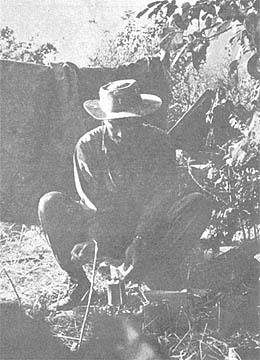 |
The Army Chaplain
|
25th Div. Bids Gen. Weyand Aloha in 'Last of Big Luaus'
The 25th Inf. Div., often called the "Hawaiian Division,"
recently held what may well have been the "last of the big luaus" at its Cu
Chi base camp.
After averaging nearly one luau per month for the last year, some
50 Hawaiian soldiers assigned to the division combined efforts to prepare the
"grandest luau of them all" for departing Division Commander Maj. Gen. Fred
C. Weyand.
Gen. Weyand left on March 7 for his new assignment as Deputy
Commanding General, II Field Force, Vietnam. Gen. Weyand commanded the
division for more than two and a half years and brought it to Vietnam last year.
The fun-filled evening featured authentic Hawaiian delicacies
including "kulua pig," which is baked while buried underground with hot
rocks, teriaki steaks, rice, long rice and Guamanian potato salad.
Hawaiian and Samoan dances, including one performed with a bright
colored baseball bat in place of the traditional flaming sword, were part of the
evening's entertainment. In addition to the dances, a group called the
"Cu Chi Short-Timers" provided soft, island music.
Maj. Rick Itao, assistant division G-1, and Maj. Ben Sugawa,
assistant division G-5, both of Honolulu, first discussed the possibility of a
luau for the general several weeks back.
Two more Honoluluans, SSgt. James Pililaau of the 25th Med. Bn. and
SSgt. Jack Uale of the Support Command Band combined efforts to produce a
delightful Hawaiian musical, complete with girls from the 12th Evac. Hosp., and
the American Red Cross.
SSgt. Terry Lambayan of the island of Aiea and SSgt. Melchor Buan
of Honolulu used their R&R for a special procurement mission to Hawaii and
returned to Cu Chi laden with Lomi lomi (salmon), lau lau (pork wrapped in tea
leaves), haupia (desert), aku (raw fish), hee (raw octupus) and fresh
pineapples.
SFC Herbert Maria, another Honoluluan assigned to the 2nd Bn., 14th
inf., superintended the food preparation and with the help of about 15 men from
all over the division, came up with an appropriately regal banquet.
The entire event was maintained at a lively pace with SSgt. William
Amina and Maj. Peter Kama of Honolulu acting as masters of ceremony.
Midway through the program, Maj. Gen. Weyand took the microphone
and thanked the Hawaiians for the "last of the big luaus." He praised
the Hawaiians for the distinctive flavor and spirit they have given the
division.
Albanian Who Fled Reds Now Fights Them for 1/14
A man who fled Communist Albania in 1955 is now fighting Communism
with the 1st Bn., 14th Inf., in Vietnam.
SSgt. James A. Reci, married and the father of two boys, has been
in Vietnam for three months. The 29-year-old Co. A platoon sergeant said,
"The Army is the best life I've had. I'm completely satisfied and proud to
be a part of it."
He is adamant about the United States in Vietnam, "It's
necessary; if we leave, the Communists take over. It's that simple."
He escaped through a minefield-barbwire border zone into Yugoslavia
from Albania in 1955 but was captured and spent six months in a refugee camp at
hard labor.
He escaped again, this time without incident into Greece and, with
other refugees, was held at an immigration point.
An enlistment team from the U.S. Army gave SSgt. Reci his chance
for U.S. citizenship.
SSgt. Reci enlisted at Frankfurt, Germany and has since served with
the "Wolfhounds" of the 25th division in Hawaii - "that unit was
outstanding," he said, and with the 1st Air Cav. Div. He has also been
stationed at Ft. Jackson, Ft. Dix, Germany, Hawaii, and Vietnam.
He became a naturalized citizen in October 1962.
'Gee, Mr. Cong, I Don't Wanna Go'
General Custer's old outfit, the 7th Cavalry, has drawn
arrow-fire again, this time from the Viet Cong.
As Co. A of the 1st battalion swept through a field south of their
An Khe base, the Viet Cong ambushed with crossbows.
However, none of the arrows found its mark and the enemy did not
stay long enough to make one last stand.
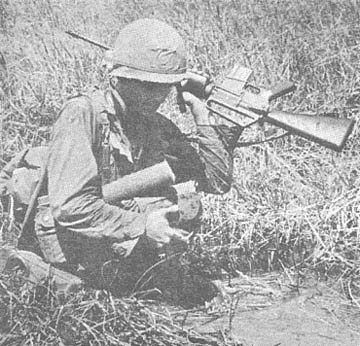 |
WADING - PFC Peter A. Guardino of New York City, assigned to the 2nd Bn., 1st Inf., manages to keep both his weapon and equipment dry while wading through a marshy field during a recent operation near Tay Ninh Province. (Photo By Sp4 Robert S. Brown) |
Page 4-5 TROPIC LIGHTNING NEWS March 20, 1967
One for Ripley: A Swimming Pool At Dau Tieng
The 3rd Bde. of the 4th Inf. Div. recently added its splash to one
of man's most unusual wars when it resurrected a stately 1930 French swimming
pool at Dau Tieng, just crackling distance from Viet Cong rifle fire.
In a scene that would undoubtedly send Lloyd Bridges under for the
third time, the combat-hardened 3rd Bde. troops have taken the new swimming pool
almost as calmly as a Viet Cong mortar attack.
"It's unbelievable!" said one specialist. "I haven't had
this much fun since I left the states. About the only thing we don't
have are girls."
Morale
And few would dispute that this was the greatest morale booster to
hit the camp since Armed Forces television brought Batman to the country late
last year.
When the Ivymen arrived in War Zone C, it didn't take them long
to uncover and overrun the dilapidated swimming pool, originally built under the
shade of the Michelin Rubber Plantation by the French in the 1930s.
The pool was marred by 20 years of neglect and war (the pipe system
was beyond use, debris contaminated the bottom, a grenade explosion had ripped
out a chunk of cement), but the potential was definitely there.
Moving
The 2nd Bn., 12th Inf., getting a chance to show its versatility,
moved in, cleaned up, then moved out, not before installing ten showers below
the sundeck, dumping 80 gallons of paint on the pool's walls and 275,000
gallons of water to fill the tank.
The result was a fabulous 81-foot-long, 31-foot-wide and
12-foot-deep pool and an opening day splash-in that resembled a school of salmon
in a goldfish bowl.
Attractions
Since opening day, the pool has taken on a few added attractions
and now features a little something for almost everyone.
The high divers have a four-meter tower, while a spring board
constructed from a helicopter rotor wing has been installed for the less daring.
A wading pool tapering down to four feet accommodates those just
wanting to relax and forget the bitter turmoil in War Zone C.
The sundeck is equipped with a stereo unit, and management has
available masks, swim fins and snorkles.
Care
The pool is managed by Sp5 Ray Croft. He is responsible for
the care and maintenance of the pool and equipment and for pool safety. He
is assisted by Sp4's Jim Fulton, Richard Webster and Cpl. Ron McAtee.
In addition to their other duties, the pool crew teaches daily
swimming classes for the non-swimmers in the brigade.
The pool is open daily from 8 a. m. to 7 p.m. No one yet has
suggested putting up night lights for a midnight swim.
That might be just too much.
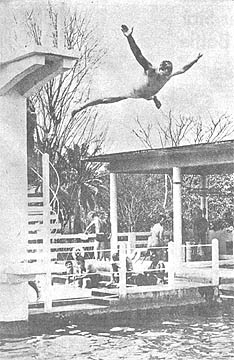 |
BATMAN - A great variety of interesting dives are practiced at the pool at Dau Tieng. |
| HIGH DIVE - The four-meter diving tower is a favorite with many a high-diving soldier. | 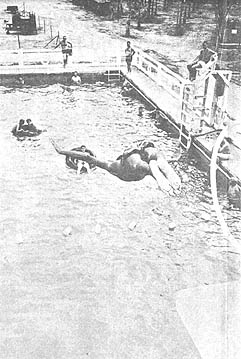 |
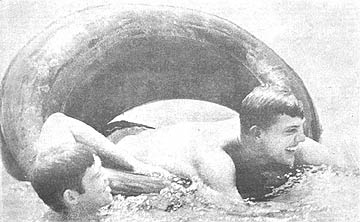 |
FUN AND GAMES - There is nothing like an inner tube in a swimming pool on a hot day. |
| LIFEGUARD - A blast on the whistle reminds swimmers of infractions of pool rules. | 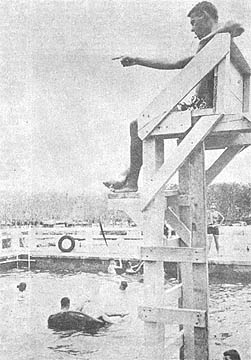 |
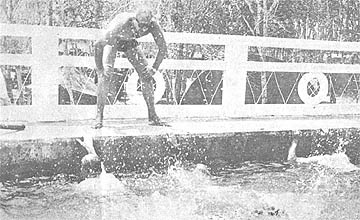 |
LESSONS - Chief life guard, Sp4 Jim Fulton, instructs daily swimming classes at the pool. |
| SPRING BOARD - A helicopter rotor blade makes an excellent spring board for this soldier's half-gainer. | 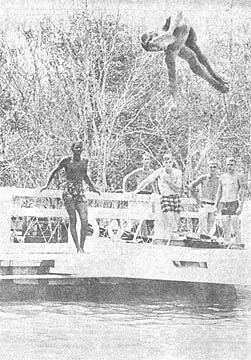 |
Page 6 TROPIC LIGHTNING NEWS March 20, 1967
G-3 Takes Look at `Junction City'
By Capt. William L. Heiberg
(Editor's Note: Capt. Heiber is newly assigned to the 25th Div.
Hq. operations section. Prior to his arrival in Vietnam, he completed a
tour of duty at Columbia University where he received his Master of Arts degree
in International Relations.)
The brain is the governing power in the human body. It
determines the direction and intensity of movement of muscles. A similar
device is necessary to direct the movement of an infantry division.
This nerve center is called the Division Tactical Operations Center
(DTOC). The brain and nerve center of the 25th Division is in a van
complex at the division forward command post at Tay Ninh.
DTOC personnel may not face the immediate combat hazards
encountered by most of the division, but their duties are by no means easy.
Two shifts, representing all support agencies, conduct a 24 hour
watch in the complex, keeping constantly in contact with the higher
headquarters, brigades and adjacent units.
Situation maps on the walls reflect the disposition of all friendly
troops, display reports of enemy activities and chart the progress of the
division in action. The command maneuvers individual units to utilize the
most effective strategy against the Viet Cong.
DTOC conducts the vast amount of coordination essential to the
smooth functioning of operations like "Attleboro," "Cedar Falls," and
now "Junction City."
Operation Junction City took place in the northwest corner of Tay
Ninh Province, long a haven for Viet Cong activities. The communists have
been allowed to develop facilities in this area without interference since the
Viet Minh insurgency began against the French in the mid-1940's.
With the exception of the recently completed Operation
"Gadsden" and activities of the Civilian Irregular Defense Groups (CIDG),
this portion of the country has been virtually untouched by Free World Forces.
The inaccessibility of the area and its proximity to Cambodia have
afforded a prime opportunity for the Viet Cong to develop their facilities.
The Rach Beng Go river on the western border of the area has long
been a major infiltration and supply route for the insurgency.
Base areas, food storage areas, hospitals, training complexes, arms
and ammunition caches, and various other installations have been constructed to
support the enemy in War Zone "C" and surrounding areas.
The 25th Division, with the attachment of the 3rd Bde., 4th Inf.
Div., and support of the 196th Lt. Inf. Bde., began Operation Junction City on
Feb. 22.
The operation was conducted with the 1st and 5th Vietnamese Marine
Battalions, designated as "Task Force Alpha." The 25th prepared to
enter the Viet Cong haven from the south, while the 1st Infantry Division moved
in from the east.
In the first phase of Junction City, both the 196th and 3rd of the
4th assumed blocking positions on the west. The 25th's 2nd Bde.
methodically worked its way north in the central zone, blanketing the area with
search and destroy missions.
Simultaneously, the 11th Armored Cav. Regt. thoroughly scoured the
east. The regiment then moved across the northern section to secure a
landing zone for the arrival of the Vietnamese Marines. The Cavalry swept north toward the Cambodian border and linked up
with the 196th Bde.
Although the results of the first phase of Junction City
are still being analyzed, one fact was immediately apparent: even in the deepest
recesses of the Viet Cong stronghold, the VC are no match for the massive
strength of the United States Army.
In the area which is suspected to have housed the mysterious
headquarters of the insurgency - COSVN - the 25th Div. advanced and destroyed
with only token resistance.
Red Cross Girls Send Out Some Birthday Reminders
Vietnam is a small country in Southeast Asia. The weather is either
hot and dry or hot and wet. Mosquitoes, scorpions and spiders abide there
in abundance. Malaria and dysentery are as common as the common cold.
There is also a war going on.
In the middle of this country, in the middle of this war, a girl
sits in a little tin roofed building making birthday cards for American
soldiers. It is incongruous; it is absurd; it is splendid!
The girl is one of eight Red Cross Recreation Hostesses serving
with the 25th Inf. Div. Club mobile Unit at Cu Chi. Every month these
girls send out more than 600 cards to soldiers serving with the 25th.
The birthday card program is headed by Ellen Felman, a 24-year-old
graduate of the University of Illinois.
More than 80 company-size units participate in the program by
supplying the names and birth dates of their personnel. The cards
themselves are designed by the girls and silk screened by hand. The cards
are then addressed to the recipients and distributed to the participating units.
There is no way to measure the success of a program such as this,
but the following letter from Sp4 Larry Glime offers some indication.
Dear A.R.C. Girls:
"Today I got my combination birthday and Valentine's day card
and I want to express my thanks to all of you. You may not be accustomed
to getting thank you letters for the hundreds of cards you sent out, but even
though I'm in the Army, I try to keep up my common courtesy. Too few
people let others know when something is appreciated.
"You may not receive much praise for your work over here, but if
it were not for you pretty girls visiting each company, this would really be a
boring place. My friends and I realize you are away from your homes just
as we are away from ours, and we appreciate that more than you think. Keep
up the good work and thank you again."
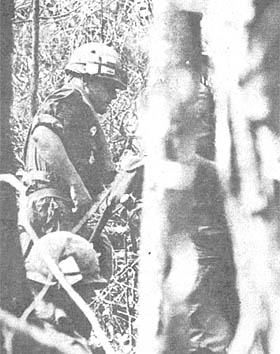 |
THE INFANTRY - SSgt. Gordon Flynn of the 1st Bn., 27th Inf., takes a break during search and destroy operations deep in War Zone "C." The 25th Div. soldiers slashed their way through the undergrowth northwest of Tay Ninh City during Operation "Junction City." |
S&T Moves 3rd of 4th To Tay Ninh Province
Due in part to the resources of the 4th S&T Co. (Prov.), the
3rd Bde., 4th Inf. Div., was able to complete movement of its entire force
within a month.
The brigade, under the command of Col. Marshall B. Garth, began its
130-km move from Camp Martin Cox at Bear Cat, to Dau Tieng, in Tay Ninh
Province, 80 km northwest of Saigon.
Convoys left Bear Cat every other day during the move. The
schedule called for the convoy to arrive at Dau Tieng the day after leaving Bear
Cat, unload and leave Dau Tieng on the third day, arriving back at Bear Cat on
the fourth day.
Through the rotating convoy concept, maximum utilization of brigade
resources was attained. SFC Edgar Larrivee coordinated the loading and
utilization of vehicles at Bear Cat through the brigade S-4. Sgt. Larrivee
is truckmaster of the 4th S&T Co.
At the other end, immediate unloading was supervised by 1st Lt.
Thomas L. Demakes, also of S&T. S&T personnel were responsible for
the unloading of the majority of the vehicles. The company's forklift
was constantly in use.
Despite an early-morning mortar attack which deadlined 11 of its
vehicles, S&T still managed to contribute 739 vehicle-available days to the
move.
Maintenance personnel of the unit did a splendid job of keeping the
trucks on the road, often working round the clock to have the vehicles ready to
go the next day.
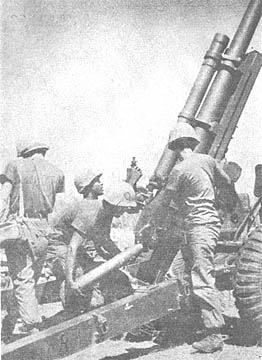 |
FIRE MISSION! - A 105mm howitzer of the 1st Bn., 8th Arty., fires into Viet Cong positions during Operation "Junction City." The artillery was based deep within the dense jungles of War Zone "C" 116 km. northwest of Saigon. |
'Brave Soldiers in Vietnam' Receive 400 Letters From
Maine Students
When you are on combat operations deep in War Zone "C", a
letter at the end on the day means a lot. For the men of the 2nd Brigade
fighting in Operation "Junction City," one hot day was a little brighter
because of a group of grade school students in snow-bound Maine.
"Just before the beginning of Junction City I received a large
cardboard box," said 2nd Bde. Commander Col. Marvin D. Fuller. "The
box contained more than 400 letters for the men of the battalions."
The letters were addressed to "The Brave Soldiers in Vietnam",
and "To a Fighting Man in Vietnam". Many contained colorful stickers
with pictures from the states.
"We love you and appreciate all you are doing for us", said one
seventh-grade student. A sixth grader wrote, "We read the news every day
to see how you are doing."
One letter to a machinegunner in the 1st Bn. (Mech.), 5th Inf.
contained cutout cartoon strips from a Maine paper. "I didn't know
whether you get to read the comics," the writer explained.
Many of the letters asked the soldiers to become penpals. If
the lift the letters provided for the men in the jungles of War Zone "C" is
any indication, there will be a lot of mail between Maine and Vietnam.
Page 7 TROPIC LIGHTNING NEWS March 20, 1967
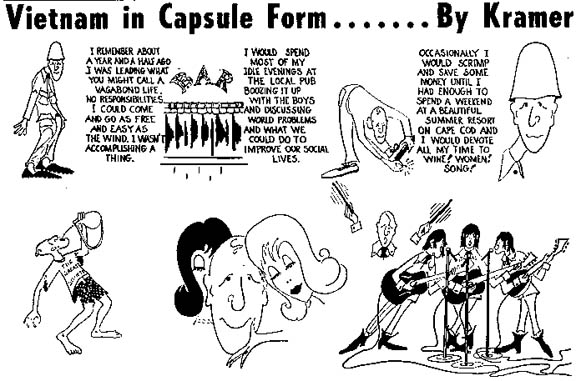 |
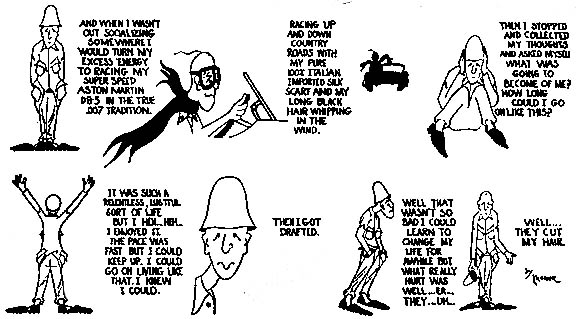 |
Tanks, APCs Roll Over Countryside, Find 3 Rats
When two M-48 tanks and six armored personnel carriers from the
25th roared into the countryside, heavily armed troopers aboard readied
themselves for another day in the search for Viet Cong.
The tracked vehicles groaned and creaked to the objective.
They slammed to a halt, ramps lowered and cavalrymen poured out.
But there was little to be found. Someone turned up a
hypodermic needle wrapped in rags. A few of the hootches contained cages
designed to trap rats. And in the middle of the hamlet were three rats
tied to a tree. Fat, healthy rats.
"It looked like the VC were fattening them up for eating," said
Platoon Sgt. Robert H. Lankford of the division's 3rd Sqdn., 4th Cav. "We shot them and hung them from a tree where the VC could see them."
The cavalrymen rolled back into base camp with little to show for
their day's work. "A hypo, a few cages and three fat rats," Sgt. Lankford
reported. Someone phoned the report to Saigon.
The next morning a chemist from Saigon showed up at the base camp.
It just might be, he told the cavalry, that the VC were experimenting with
disease cures or biological warfare.
Two M-48 tanks and six armored personnel carriers containing one
chemist and a platoon of cavalrymen roared back into the countryside. When
they got there the rats were gone.
"Drat! " cursed the chemist. "Rats! " said Sgt.
Lankford. But another search turned up a bottle of clear liquid and a new
dead rat.
The chemist stuffed the rat into a sack, pocketed the bottle of
liquid and headed back to his laboratory to evaluate his finds. (S&S)
Page 8 TROPIC LIGHTNING NEWS March 20, 1967
Colonel Decorated at Change of Command
Col. Daniel B. Williams, former commanding officer of the 25th
DivArty, recently handed the unit's colors to Col. David E. Ott, former
executive officer of II Field Force Arty., during change of command ceremonies
held at the DivArty forward headquarters at Trai Bi.
During the ceremonies Col. Williams was awarded the Vietnamese
Gallantry Cross with Silver Star by Brig. Gen. Chinh, commander of the 25th ARVN
Div. Col. Williams also received the Silver Star and the Air Medal with
the 6th through 14th Oak Leaf Clusters from Maj. Gen. Fred C. Weyand, former
25th Inf. Div. commander.
Col. Williams was awarded the Silver Star for heroic actions on
July 4, 1966 when he directed his command helicopter into hostile territory to
rescue a wounded sergeant.
Col. Williams was visiting the operations center of Operation
"Fireball" when he learned that a two-company Civilian Irregular Defense
Group had been ambushed by an estimated Viet Cong battalion and that a American
liaison sergeant had been seriously wounded and required immediate evacuation.
When Col. Williams arrived at the scene, he directed the helicopter
into a position so that a rope could be lowered through the jungle foliage to
extract the wounded sergeant. The sergeant was immediately transported to
the nearest medical facility. Dauntlessly, Col. Williams returned to the
task force and, after determining the exact location of the friendly and enemy
forces, successfully directed over 300 devastating artillery rounds all around
the perimeter of the beleaguered force.
He adjusted fire that cleared a path before the advancing friendly
element so effectively that they were able to disengage from the numerically
superior enemy force with only minor casualties.
Col. Williams is now beginning his new assignment at the Office of
the Chief of Staff, Forces Development, Headquarters, Department of the Army.
'Guardian' Helps Blind Orphan
Tu Yet is an eight-year-old orphan, who, since the age of three,
has been totally blind. She lives with 60 other children in the Co Nhi
Vien Orphanage in Tay Ninh Province.
When the 196th Lt. Inf. Bde.'s 2nd Bn., 1st Inf., adopted the
orphanage in December, they began making weekly trips to give medical and dental
care for the children. Each time they visit the orphanage, Tu Yet is the
center of attraction.
Tu Yet contracted measles when she was younger which caused her
eyes to become scarred. Though it had been five years since her illness,
the "Guardian" battalion arranged for her to be flown to the 93rd Evacuation
Hospital in Long Binh and the 17th Field Hospital in Saigon for treatment.
Nothing could be done to restore her sight.
Though Tu Yet will always be blind, with the help of Capt. Edward
L. Garr of Los Angeles, the battalion surgeon, her future may be brighter.
Capt. Garr hopes to teach Tu Yet to be an interpreter by introducing her to the
Braille System for the blind. He has asked the Braille Institute of Los
Angeles for Braille books to teach her the English language.
"The blind can make fine interpreters because nothing distracts
them and they feel they are doing something useful and worthwhile," Capt. Garr
said. "Of course, this will take time, but it can give her a useful
future."
Helicopter Pilot 'Dusts Self Off'
"My biggest worry was how I was going to land the ship. You
have to be able to use the right foot pedal to land, and I couldn't."
Thus a 196th Lt. Inf. Bde. helicopter pilot related the experience that had
caused him, a few hours earlier, to become his own Medical Evacuation (MEDEVAC)
pilot.
1st Lt. Robert E. Crawford of Starkville, Miss. was on a routine
flight from the brigade's base camp to the forward command post for Operation
"Junction City." Alone in his OH-23 "Bubbletop" helicopter, he had
reached an altitude of 260 meters and was flying approximately 8 km. north
northwest of Tay Ninh City.
Lt. Crawford said, "I saw a 'Caribou' (supply plane), which
was apparently going to land at Tay Ninh, coming towards me. To get out of
his way, I started to turn to the right.
"Just as I turned, I heard three shots and felt a sting in my
right foot. I knew that I'd been shot, and looked down and thought I saw
blood. I gave the chopper all the power I could and turned back to Tay
Ninh."
The 26-year old pilot is a veteran of more than 400 hours flight
time since arriving in Vietnam in November.
"I tried to use my right foot but I couldn't do it," he said.
"As I approached the base camp I started letting off power to prepare for the
landing. The ship swung its rear end around to the left, which is the
natural reaction, and I was flying sideways. I tried to let off power as
gradually as I could, knowing that if I'd let off abruptly, the chopper would
have started spinning completely around, and that would have really been it.
"My biggest worry, though, was how I was going to land the ship.
I radioed operations and explained the situation, and asked them to have someone
from the hospital at the dustoff pad in case there was trouble.
"I flew from the perimeter of the base camp to the 45th Surg.
Hosp. dustoff pad with the chopper still going sideways. When I was
hovering a few feet over the pad, I increased power gradually, so the chopper
could straighten out, and then just cut the power and dropped it onto the
ground."
The bullet that hit Lt. Crawford had passed through the frame of
the radio, through his right foot, and out the door of the chopper.
Many had watched as the "Bubbletop" had glided sideways over
the base camp and onto the dustoff pad at the hospital, but no one had guessed
that Lt. Crawford was flying his own MEDEVAC.
| OH WHAT FUN IT IS TO RIDE - These two happy cyclists are members of the 2nd Bn., (Mech), 22nd Inf., part of the 3rd Bde., 4th Inf. Div. The men captured the two-wheeled transportation after a brief firefight near the Cambodian border in War Zone "C." | 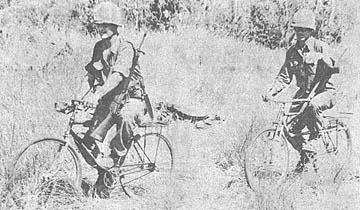 |
How 3/21st Built Jungle Airstrip
The "Gimlets" of the 3rd Bn., 21st Inf., 196th Lt. Inf. Bde.,
were credited with a Vietnam first when, using only hand tools, they carved an
airstrip out of triple-canopy jungle, deep within Viet Cong territory during
Operation "Junction City."
An airstrip large enough to accommodate planes such as the Air
.Force's CV-7A "Caribou" was needed to ferry in vital supplies for ground
troops working the jungles of notorious War Zone C.
The "Gimlets" decided to build the landing strip themselves,
with no help other than a five-man Air Force advisory team.
Co.'s A, B, and C boarded helicopters which carried them to the
proposed airstrip site. There they met with intense Viet Cong fire while
disembarking. After driving the enemy from its bunkers and trenches, a
secure perimeter was established and the "Gimlets" got busy on the airstrip.
Finding a cleared area with a natural laterite base, the
infantrymen-turned-engineers concentrated on clearing approach paths and
leveling and improving the landing strip. The only tools used were power
saws, axes and explosives.
The Air Force eased the Gimlets task in an unusual way by striking
a thick jungle area interfering with the proposed approach. The jets
swooped in and dropped bombs, blasting and burning away jungle obstacles.
The Air Force team checked the alignment of the strip and made sure
the approaches were suitably clear. Finally the airstrip was completed.
An Air Force "Caribou," piloted by Air Force Maj. Douglas J. Thiel of the
458th Troop Carrier Squadron, circled the field and made his approach. The
twin engine aircraft made a fine landing, using almost all of the strip's 1150
feet before coming to a stop.
Thus the new airfield was christened. Maj. Thiel taxied his
"Caribou" up to the battalion command post, where he was congratulated by
Gimlet commander, Lt. Col. Graham M. Sibbles of McLean, Va. The first
airship also carried a valuable cargo. Gallons of chilled iced tea were
unloaded, adding a touch to the airfield's grand opening.
To commemorate the achievement of the infantrymen, a small sign now
stands in that jungle clearing, officially designating the spot "Gimlets'
International Airport."
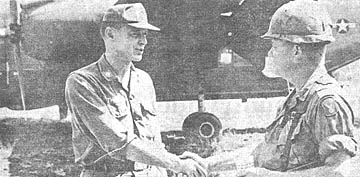 |
FIRST IN - Lt. Col. Graham M. Sibbles (r), commanding officer of the 3rd Bn., 21st Inf., congratulates Air Force Maj. Douglas J. Thiel of the 458th Troop Carrier Squadron after the major landed his CV-7A "Caribou" at the battalion's "Gimlets' International Airfield." |
25th Div. Praised
The 25th Inf. Div. received a letter of commendation, praising the
division for an outstanding performance during a recent USARV inspection.
Lt. Gen. Jean E. Engler, deputy USARV commander, wrote that "the
Inspector General was greatly impressed by the receptive attitude of personnel
toward the inspection and the overall outstanding condition of the division."
Thanks to
Arthur B. Neighbor, 228th Supply & Service Co. (Direct Support) for sharing
this issue,
Kirk Ramsey, 2nd Bn., 14th Inf. for creating this page.
This page last modified 8-12-2004
©2004 25th Infantry Division Association. All rights reserved.